Please find the latest news posted on the latest news page
Timeline of WCS License Application Events
[note: Alot of the documents in this list are available at the TCEQ website from this page]
Aug. 4, 2004- WCS submitted its license application to TCEQ for disposal of "low-level" waste. (This link is also where to find revisions/additions WCS has made in response to TCEQ.)
Sept. 17, 2004- TCEQ sent 1st Administrative Notice of Deficiency (ANOD*) to WCS.
Nov. 17, 2004- TCEQ sent 2nd Administrative Notice of Deficiency* to WCS.
Jan. 14, 2005- TCEQ sent 3rd Administrative Notice of Deficiency* to WCS.
(*specifies what additional information is required to satisfy the noted deficiencies)
Feb. 18, 2005- TCEQ determined WCS's application to be administratively complete.
Mar. 31, 2005- TCEQ held a public meeting at Andrews High School to receive comments on WCS's application (view transcript)
May 2, 2005- TCEQ published the Evaluation of Merit Report including a response to public comments
- Evaluation of Merit Cover Letter
- Attachment A - TCEQ Evaluation Table
- Attachment B - Response to Public Comments
- Attachment C - Transcript of Proceedings, Public Meeting 3/31/05
- Attachment D - Written Comments
July 20, 2005- TCEQ issued WCS a courtesy letter with early notification of issues that are of fundamental importance to the consideration of the WCS application.
Fallout From 2003 Texas Legislature: TWO New Huge Nuclear Dumps
This years State legislative session moves most of the content on this page into a context of historical background. The new changes to Texas law made this year deliver to WCS exactly what they have been wanting for years on a silver platter: the ability to dump hundreds of millions of feet of waste in Texas.
The new changes to Texas law allow a private company to not only become licensed for the disposal of radioactive waste, but to operate two huge dumps at the same site. Supporters of the bill maintained that other companies could fill this role, but this was widely regarded as a joke, since it is understood that WCS is the beneficiary.
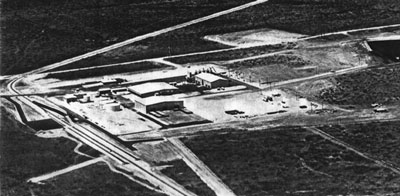 |
One dump will be dedicated to disposing waste from the Texas Compact. This deal includes waste from Texas, Maine and Vermont, but also lets waste from anywhere in the United States through a loophole in the Compact law. Over 95% of all of this waste comes from commercial nuclear power plants.
The second dump is exactly what WCS has wanted all along. This dump is to recieve federal waste, which primarily comes from the Department of Energy (DOE), but can also include waste from decommissioned Naval vessels. The rest of what is defined as federal waste actually makes up the majority of whats included in DOE waste, that is, waste from "any research, development, testing, or production of any atomic weapon." This nuclear weapons waste from the DOE consists of everything from decommissioned reactor vessels used in the production of plutonium, to highly contaminated soils and building materials from these all of these facilities. As discussed in the section on waste amounts, the DOE is going to have hundreds of millions of cubic feet of waste per decade for many years before these sites will be cleaned up.
With the bill that just passed, WCS would be able to take a total of 162 million cubic feet of waste at the federal dump, and this is about what could be realistically transported and dumped at a facility in the given time. This was called a waste "cap", but clearly leaves the company unfettered in the short term. This number may also be raised later if future legislative sessions do so, so in addition to repealing this bill, Texas must be very careful that things dont get even worse.
Folks, we are in serious trouble, so please spread the word! If the public does not act, the dumpsites could later end up taking commercial power plant waste from all over the country in unlimited amounts! Texas must not be allowed to be turned into a dumpsite for the DOE or the nuclear industry.
This process is going to be drawn out of the next few years, so we still have time to act. We will be paying close attention to what happens at the Texas Commission on Environmental Quality (TCEQ), the oversight agency, but also elsewhere. There will be public hearings, and we will also be able to send in written testimony and petitions.
The Dallas Morning News reported that WCS officials told them that they "hope to begin receiving the material as early as 2005." On the current schedule, the dump can't open until 2008. This tells us that they will seek to expand the law even further during the next Legislative session, so that the larger federal dump will be open long before waste from the Compact ever arrives in Texas. They may also try to increase the sites "capacity" or add more dumps!
---> View The Hydrology Materials and Maps Section (Hydrology and Seismicity)
The site is at a ranch known as Windmill Hill in Andrews County, Texas. Not only is this disposal site located above two aquifers, (the Ogallala and the Dockum), but there are also aquifer recharge features on the property. The Ogallala aquifer ranges under 7 other states: New Mexico, Oklahoma, Kansas, Colorado, Wyoming, Nebraska, and South Dakota; demonstrating that opposing the WCS facility is not just a "not-in-my-backyard" stance.
Thier hazardous waste pit, where they have dumped several million cubic feet of toxic waste and low-radioactivity trash, is actually dug into the Ogallala which is around 35 feet below the surface. It has a plastic lining, which historically have been found to leak. The company bought 16,000 acres in it's earlier days and has licensed 1,600 acres for its hazardous waste disposal area.
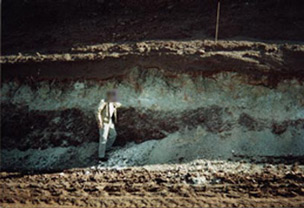 |
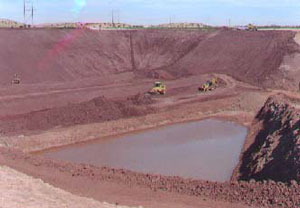 |
| Pictures taken during the digging of the hazardous waste pit. [left]: A visiting geologist shows us an aquifer feature called a sandtube, which is seen on the wall of the pit . [right]: It had rained the previous evening, and flooding was apparent at the bottom of the pit the next day . | |
The presence of the Ogallala, and a 100-year floodplain which extends through the facility boundary, have been denied by WCS. The site is also located within 10 miles of the feedwaters of the Lower Colorado River, which flow through Austin 12 blocks from the State Capitol. This subject has never been raised in any discussion on site suitability.
The area is also seismically active with 18 seismic events counted within a 30 mile radius (48 km). Of these, the latest occurred on June 2, 2001 at a depth of 5 km, with a 3.3 magnitude, and the largest occurred on January 2, 1992 approximately 15 miles from the site with a 5.5 magnitude. Eight of these events happened in 1976 alone.
The TDH never conducted an Environmental Assessment (EA) for the WCS Andrews facility. What was used instead was a report which WCS submitted and which contains some serious flaws. It denies the presence of the Ogallala aquifer on the property, claiming that each of the other geological studies done on the site have confused the Ogallala Formation with "Antler's Sandstone." The Antler aquifer, of which Antler's Sandstone is indigenous to, is in southeastern Oklahoma and northeast Texas over 350 miles away.
---> 1993 Geological Survey of the Andrews Facility (Cross-Sections)
 22MB [PDF]
22MB [PDF]
A detailed geological survey was conducted of the site in 1993 as part of it's application with the TCEQ (then called the TNRCC). This study is included with the rest of WCS's file at the TDH. It not only proves the presence of the aquifers at the WCS, but also the 100-year floodplain. The report WCS submitted as an site assessment makes references to this report, yet unscientifically attempts to debunk its most important findings by scratching out the word Ogallala and replacing it with Antlers Sandstone. They gave no evidence to support this claim, and the State's Bureau of Radiation Control (TxBRC) produced no documented review of the submitted site geology. Later, geological suitability of WCS was criticized by the University of Texas Bureau of Economic Geology for not providing sufficient evidence of its claims for suitability as a radioactive waste dump. In response WCS changed their story, and developed a second geological survey which showed that the Ogallala was
---> Review of Data on Hydrogeology and Related Issues in Andrews Co
- University of Texas Bureau of Economic Geology, January 1999
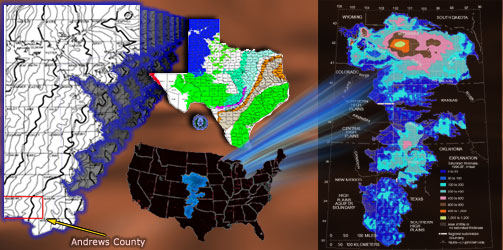 The Ogallala, aka the High Plains aquifer, the largest aquifer in the United States. On the left, the portion in Texas including Andrews County; on the right, the size of the aquifer in the nation. |
Waste Control Specialists is owned by a larger company called Valhi. Valhi is controlled by a man named Harold Simmons, who has been known as the second richest man in Texas. Since Valhi also owns National Lead Industries, one of the worst polluters in the US, Simmons has also been called the 'king of superfund sites'.
Valhi and Simmons give millions in campaign contributions to Texas representatives. Simmons was 2nd biggest donor ($90,000) and #1 fundraiser in the Bush for governor campaign. He also was a large donor in two of Jeb Bush's Florida campaigns. Through Contran, another company in the Simmons' empire, millions more is also funneled to GOPAC and the GOP in soft money contributions to influence the political process on a national level. The Houston Chronicle stated Simmons personally was one of the primary contributors to the Bush presidential campaign. Campaign contributions for the year 2000 include $70,000 for Sen. Kay Bailey Hutchinson, $350,000 for Sen. Phil Gramm, and $211,000 for Gov Rick Perry. Just prior to the 2001 legislature, he gave $10,000 to Sen. Buster Brown, Chairman of the Senate Natural Resources Committee.
 Simmons and his money club: Bush, Perry, Dewherst, Hutchison, Gramm, Cornyn, Brown, and Craddick. |
By this November, Simmons contributions to the 2002 Texas election cycle include: $201,000 more for Gov Perry, $8000 for Lt. Gov Dewherst, $10,000 for Atty Gen Cornyn, $20,000 to Comptroller Rylander, $9500 for Commissioner candidates, $5000 each to Supreme Court candidates Schneider and Wainwright, over $11,500 to 10 House candidates, and over $12,500 to 10 Senate candidates. Notably, Simmons also gave at least $8000 to democrats running for Senate including Wollens, Cain, and West
Majority stockholders like Kent Hance also make thier own additional large contributions.
Campaign Contributions from WCS
==> Harold Simmons' Texas campaign contributions 1995-2003
==> Simmons' Family Federal campaign contributions 1989-2003
==> Kent Hance's Federal campaign contributions 1989-2003
==> Hance's Texas campaign contributions 1994-2003
==> Company Federal campaign contributions 1989-2003
Not only has Simmons been in court by the US government several times for violating campaign contribution laws, but he also has been taken to court by his daughters for making illegal contributions in the names of his own family members without their consent. (He settled that lawsuit for $50 million)
Both Gayle Norton (Secretary of the Interior), and Dick Cheney (the Vice-President) were previously employed by Valhi. Norton was an attorney and lobbyist for Valhi, defending Natl Lead Industries in lawsuits involving lead paint poisoning and schoolchildren. Cheney, who is well-known as having been the former CEO of Halliburton when primarily owned by Valhi, presented President Bush's energy plan. (Halliburton's subsidiary Brown and Root has been heavily involved in Comanche Peak and STNP in Texas, but is nationally is quite involved in nukes, including nuclear submarine manufacturing.)
[Texans for Public Justice, New York Times, The Houston Chronicle, and others]
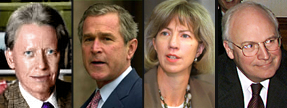 Left to right: Harold Simmons, US Pres. George W. Bush, Sec. Int. Gayle Norton, and VP Dick Cheney. |
WCS's License for the Andrews County facility
WCS has a radioactive materials license to process and store radioactive waste as well as a separate facility with a hazardous materials disposal license. WCS can receive LLRW for processing and/or storage, and can dispose of "exempted" LLRW. Material can be labeled as "exempted" if found to radiate particles at a small enough amount to be deemed "below regulatory concern." Once LLRW has been exempted it is outside the regulatory restrictions placed upon radioactive materials, and can be transferred to the onsite hazardous waste landfill pit for disposal. [The requirements for exempt material are defined in 25 TAC § 285.251(c) (1), which is the Texas counterpart to 10 CFR 40.13(a)]
----> View TDH/ TNRCC Open Records Documents about WCS, 1997-2001
For disposal, WCS has been receiving quite a bit of exempted waste over the years, and it is one of the sites biggest selling points to waste generators, including the Department of Defense. This is because it is cheaper to dilute waste and dump it into a landfill than to pay the high prices of a licensed radioactive waste disposal facility. This material is not placed in a separate area of the hazardous waste dump, and to date, neither the Texas Commission on Environmental Quality (formerly TNRCC) or the Texas Bureau of Radiation Control has been keeping track of the amounts of exempted radioactive waste which are disposed of at WCS. Several hundred-thousand cubic feet of this waste has been dumped at Andrews.
 |
One of the things WCS does is store waste onsite. During 2001-2002, WCS succeeded in obtaining NRC permission for increased volumes of Special Nuclear Material, which is the most volatile subcategory of low-level radioactive wastes, including materials containing fissionable plutonium and uranium which aren't source materials themselves. (the NRC can designate any material as Special Nuclear Material under certain provisions, such as in the interest of National Security) (USC 42 §§ 2014, 2071, NRC.)
WCS has been trying to obtain a license for radioactive material disposal for years, but until 2003 Texas law has prohibited a private company from operating a dump. WCS uses a strategy of inching it's way as close as possible by attempting to obtaining license amendments and intensely lobbying the Texas legislature. Some feel that the buildup of disposed exempted wastes may be a ploy to charge that radioactive waste is already disposed of there, as an excuse for future conversion to a full disposal license. In addition, WCS is also seeking a separate type of radioactive disposal license for what is called 11e2 byproduct waste.
Byproduct wastes is generated under conditions of uranium ore milling, where wastes known as tailings are produced, and in the refinement of uranium from that ore. Tailings are slated for cleanup under a program called the Uranium Mill Tailings Remedial Action Project (UMTRA). In addition, 11e2 byproduct waste also originates from Cold War bomb development projects known as the Manhattan Project, which were conducted at sites across the country. A project to clean up this waste is called the Formerly Utilized Site Remedial Action Program, which is run by the Army Corp of Engineers, who has even been known to send this material to municipal landfills when authorized to do so.
[Texas Dept of Health Bureau of Radiation Control, independent research and sources]
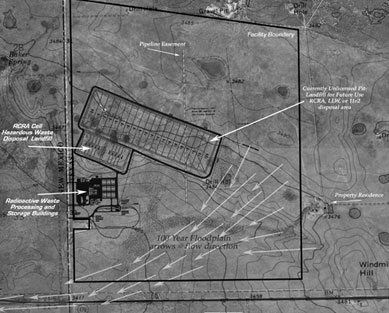 |
WCS's Reputation around the Texas Capitol Nothing New
Andrews County has a long history in the oil business. In 1929, when oil was discovered, Andrews became the largest oil producer in the US. In 1966, the Chamber of Commerce formed the Andrews Industrial Foundation (AIF), a small group of wealthy business leaders, which would control economic development in the County to present day. During the OPEC embargo of 1973, the sharp rise in oil prices stimulated oil production and profit in Andrews. After the oil boom, prices dropped, and the AIF began to look to other means to attract new business. Throughout the 1980s, the Foundation began lobby for nuclear industry projects. When the DOE was investigating the suitability of Deaf Smith County for high level waste disposal (later sited at Yucca Mountain), Andrews had actively sought to also be a candidate. Andrews was also runner-up in the bid for the Superconducting Super-Collider project. None of these proposals met suitability requirements, primarily due to the presence of the Ogallala aquifer in the county. By 1986, oil prices hit bottom, and Andrews' economy was drooping from it's previous heights.
June 1987, the TLLRWDA had been contacted about siting a disposal facility owned by the University of Texas about 20 miles east of the town of Andrews. When the TLLRWDA visited the proposed site and noted that the site was probably not suitable due to the proximity of the Ogallala, the Andrews Board asked to begin drilling test holes to demonstrate this wasn't the case, which they did, and found the Ogallala 40 feet just below the site. The TLLRWDA newsletter said, "protection of the State's waters is perhaps the most important siting criteria that the authority must meet. With the presence of the country's largest aquifer located a mere 40 feet below the surface, the Andrews County site was immediately disqualified." (as a sidenote, it should be pointed out here that water issues were never a concern of the TLLRWDA when it came to the Sierra Blanca dump, and this had contributed to a feud between the Andrews Industrial Foundation (including WCS) and the TLLRWDA).
Waste Control Specialists LLC (WCS) was formed in 1989 by Houston Industrialist Ken Bigham, with the goal of building a hazardous waste dump. Bigham bought 16,000 acres in Andrews on the Texas-New Mexico State Line and planned a 11,274,000 cubic yard landfill on the property. In March of 1993, WCS applied to the TNRCC for a RCRA Part B permit, which allows disposal of all hazardous chemical waste (over 2,000 toxic substances), and were granted a license in record time by August 1994. Less than one year later, WCS cited a declining market for hazardous waste disposal, and with the blessing of the Andrews Industrial Foundation, began to bid for the disposal of "low-level" and mixed radioactive wastes.
In 1995, WCS lobbied the Texas Legislature, and caused quite a stir-up when two of their lobbyists, John Birdwell and former congressman Kent Hance, were exposed trying to get an outspoken republican opponent of their radioactive waste bill to change his mind by promising $60,000 in campaign contributions in the next elections. Reps Robert Talton (R-Pasadena) and Ray Allen (R-Grand Prarie) reported the incident to the executive assistant to House Speaker Pete Laney, and the District Attorneys office. Allen stated that he had been approached by Birdwell who said of Talton,"why, they would put $60,000 in his campaign in a heartbeat if he would back off." Allen stated that "it certainly sounded like a bribe using campaign contributions... There was clearly a linkage between the campaign contributions and Robert dropping his opposition." Tarlton mentioned that Hance had also approached him concerning a possible opening in his law firm (Hance, Scarborough, Woodward, and Weisbart) becoming available if he dropped opposition to the bill. "He implied that he needed another lawyer in Houston," Talton said. "And I said I made over $1 million last year, and I don't need this."
Hance denied everything. He stated that it was a "cheap trick" to kill the bill, and went on to say "it is an absolute lie... I don't know what he is smoking. This guy is out of control. The bill comes up tomorrow, and he hates my client." Hance was refering to the fact that Talton knew Ken Bigham, then-president of WCS, and had some disagreement over 20 years before when Talton was on the Pasadena police force, and Bigham had worked for the Harris County Sheriffs Office. Hance claimed that Talton had said he still hates Bigham and said of Talton, "he's going to do whatever he can to get rid of him." Talton explained that he and Bigham had a disagreement, but that it was 20-25 years ago, and that he hadn't seen Bigham since. Addressing the entire situation, including Hance's suggestion that opposing the bill was some sort of vindictive move by Talton, Rep Allen pretty much summed it up saying, "this is a stinky deal, and the public needs to get a whiff of this"
This bill was introduced by Senator Teel Bivins, and would have allowed a private company to obtain a radioactive waste disposal license. WCS could then bring in and dump enormous portions of waste without hinderance. The bill was killed, revived, and killed again during the closing days of the Session. In future legislatures, Senator Bivins would continue to introduce bills which would enable WCS to become a national radioactive waste dump.
This episode was obviously a huge embarrassment to WCS, but they were soon rescued in November, when 50% of WCS was bought by Dallas-based Valhi Inc., run by billionaire Harold Simmons, who is a personal friend of George W. Bush and major contributor to his campaigns. Simmons had a reputation for funnelling massive campaign contributions to state and federal candidates, and had an team of high paid Washington lobbyists to orchestrate these Congressional allies when elected. Between 1994 and June of 1996, according to the Dallas Morning News, Simmons, Bigham and Hance donated over $170,000 to Governor Bush and Lieutenant Governor Bob Bullock. Simmons had also discussed the issue with Bush when Governor. "I basically told George that I was involved in the company as a major investor," Simmons told the Morning News, "and I wanted him to be aware of it in case the issue ever came up."

WCS lobbyists Kent Hance, Chet Brooks, Billy Clayton, and Carl Parker |
The lobbying team for WCS has been made up almost exclusively of ex-state officials and congressmen. Leading up the team was Kent Hance, former Railroad Commissioner, who represented Andrews County when he was a Congressman in the 1980s. Hance was a WCS major stockholder and Chairman with an option to buy 25% of the company. Carl Parker is a former state senator (D-Port Arthur); Chet Brooks, a former state senator; Cliff Johnson, former state representative from Palestine who served as commissioner of the Texas Water Board; Jim Rudd, former state rep from Brownfield; Daryl Owen, former top aide to the senate energy committee.
WCS was in hostile competition with the State of Texas LLRWDA, who was busy attempting to build a dump of their own. At a legislative agenda meeting of El Paso city, county, and state officials held December 1996, a resolution opposing the Sierra Blanca site was unanimously approved. According to those present, only one official wanted to request specifically that the compact dump be moved to Andrews County: El Paso state representative Pat Haggerty. Ethics Commission filings show that Haggerty received campaign donations from Ken Bigham, and WCS lobbyists Chet Brooks and Carl Parker - all on the same day, and only a few weeks prior to the El Paso meeting.
By early 1997, WCS had submitted an application and soon afterward was granted a license to process and store, but not dispose radioactive waste at Andrews. This and the 75th legislature occured in the midst of a 20-month lawsuit between WCS and the DOE. The Dallas Morning News obtained court documents after the dismissal of the WCS vs DOE lawsuit in 1998 which revealed a number of things about WCS's character. In line with the Simmons-Valhi reputation, WCS had been hiring well-connected lobbyists in Washington, for example, former top Senate Energy Committee aide Daryl Owen had been lobbying for WCS since October 1995, and was promised a huge $18.4 million award if successful. By this time, Simmons, Bigham and others connected to WCS had already donated over $90,000 to key senators and House members.
Also revealed was that Kent Hance had asked three senators who had recieved large WCS contributions to block the nomination of Mary Anne Sullivan for DOE General Counsel, which succeeded [the three were Shelby (R-Alaska), Hutchison (R-Texas) and Gramm (R-Texas)]. WCS was even getting its congressional allies to assist in things like letterwriting campaigns. One targeted at Energy Secretary Federico Pena asked him why his department was still doing business with Envirocare, and urging him to reconsider WCS proposals during the WCS vs DOE lawsuit. Gramm, Hutchison, and Shelby were among the letterwriters, which included one letter signed by 18 of the 30 Texas House members, nine of whom had received donations from top WCS supporters.
Wright Andrews, past president of the American League of Lobbyists, said WCS's lobbying has been hard-edged, even for Washington. "It sounds as thought this has been an exceptionally aggressive and very political lobbying effort." He continued that he had lobbied Congress on nuclear waste issues before, "but it sounds like it is high-stakes"
Repeatedly, and unsuccessfully, WCS would introduce bills into every Texas Legislature which would allow a private company to be granted a disposal license, thus allowing them to dump waste in unrestricted amounts from all over the nation. Not unlike a child who repeatedly asks the same question over and over until the targeted adult, exasperated, gives in with the desired answer, WCS continues to harrass our elected officials and regulatory agencies to have its way with changing Texas Law to obtain the hundreds of billions in profits it seeks. When the vast campaign contributions and other breaches of ethics reaches critical mass, it becomes clear that the adults are forced to discipline the child, meaning that at some point the abuse of corporate accountability will reach a point where State and Federal governments will have to say "enough's enough."
Is Radiation "Our Friend"?: Manufacturing Consent and Hitting the Young
In 2003, after the site was legislatively-enabled to become a dumpsite for the nations waste, the Dallas Morning News printed an article attempting to demonstrate local support for the dump, with interviews from the Andrews Chamber of Commerce, which houses the Andrews Industrial Foundation. It also interviewed manager who previously worked for a hazardous waste incinerator, assuring that everything was safe in the neighborhood.
Most notably, WCS is practicing a public relations campaign which has been seen before in Sierra Blanca. Recruiting and inventing poster children from local high schools. The Morning News article quoted a Andrews High School graduate "who admits to not knowing much about the science of the plan" saying "the company's community involvement influenced her opinions.
|
"...She noticed Waste Control Specialists' presence after the facility opened in 1997 and new
faces starting showing up at school and the company logo began appearing on
softball and Little League uniforms. Then this year, the company gave her a $1,000 scholarship-
for which she never applied- to defray tuition at the University of North Texas, where
she plans in the fall to study marketing or public relations. Several
classmates received the same gift, she said.
"It was pretty cool that they picked me", working behind the counter at her job inside Ribbons and Bows, a gift shop on Andrews' central street. "I don't really know how [the site] affects us. But it doesn't affect my daily life." |
Notice that this means WCS has been doing this heavy saturation marketing onto children in Andrews since she herself was approximately in the 6th grade (1997- 6 years previous). The fact that WCS has been indoctrinating the local stakeholder population for years must be a considered factor in this case.
This is such a familiar story, repeated elsewhere innumerous times by different hazardous chemical and nuclear industries.
For more on this, heres a short article talking about Sierra Blanca's high school.
Nuclear Waste Is Good for You - The Texas Observer; Jan 30, 1998; by Richard Boren
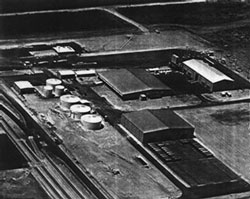 |
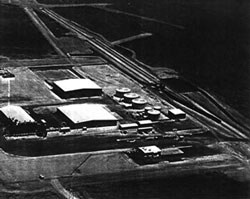 |
The DOE v.s WCS Lawsuit (Sept 1996-May 1998) : Bypassing State Law
Envirocare's Utah site is the nation's only state-licensed private low-level waste dump, and has been the source of much aggressive rivalry with WCS. During a lawsuit with the DOE, WCS claimed that Envirocare had monopoly status on dumping DOE waste, and that WCS should also be able to open a DOE dump in Texas and reap the promised billions in profits. Before WCS delivered its proposal to the DOE or the TNRCC in the case, Envirocare Chief Executive Khosrow Semnani bought up 880 acres near the WCS site and notified the TNRCC of an intent to license a federal DOE dump which served as a pre-emptive strike against WCS, forcing a TNRCC policy decision before WCS could act.
Since WCS was unable to change Texas law in 1995 to allow a private company a license for a dump, they prepared a method to bypass state law. In September 1996, WCS submitted a bid in response to a DOE open call for proposals to take waste from it's plant in Fernald, Ohio. Part of the deal was that the company must take title to the waste, and be able to get the proper disposal permits. The DOE did not see WCS as qualifying, and just about the same time on October 18, TNRCC denied Envirocare's request for a license, saying it didnt have the legal authority to grant such a permit under state law. TNRCC executive director Dan Pearson sent a letter to WCS saying the same thing, and emphasized that as a matter of policy the agency was opposed to "any scenario or arrangement" that involved state oversight of a private disposal facility.
In a second letter, Pearson suggested that a federally regulated DOE site was a legal feasibility, and if such a proposal were formally made it would merely require a policy decision by the TNRCC's three commissioners, who were all Bush appointees. WCS's response was to submit another proposal to the DOE which outlined how they could operate a dump legally under DOE contract without obtaining a state or NRC license. This also involved a research partnership with Texas Tech University. They had hoped that if the DOE opened a site with them at Andrews, that this would exclude the State of Texas from having any say in the process, for they claimed that as a DOE contracted site, they should be exempted from State regulation. Citing internal policy, the DOE said they couldn't do it, so WCS filed a complaint saying its proposal could be lawfully implemented and that DOE unfairly rejected the proposal. DOE responded that they did see what WCS proposed as being lawful, but that alternative regulatory agreements such as suggested were not covered under a poilicy decicion.
On October 3, 1997, Judge Joe Kendall of the U.S. District Court for the Northern District of Texas, Wichita Falls Division, heard WCS' case against DOE, and issued a preliminary injunction against DOE. He determines that a state and/or NRC permit is not necessary for DOE radioactive waste disposal at a privately-owned site under contract with DOE. The injunction barred DOE from awarding contracts for the disposal of low-level and/or mixed radioactive wastes without considering bids from WCS.
By February 1998 the lawsuit sped up when it came to the attention of the National Governors' Association, who weren't too pleased that the DOE considered the WCS proposal as legal (since it infringed on state rights). WCS started asking for injunctive reliefs such as: preventing the DOE from using U.S. Army Corps of Engineers contracts to ship their low-level wastes to Envirocare's private dump in Utah; and, keeping the DOE from shipping low-level wastes to states unless an agreement existed with a particular state. Two days later, sixteen states responded very concerned, with an amicus brief of a full statement condemning WCS's arguments.
Among other things they said, "if a privately owned and operated facility that seeks to profit from disposing radioactive waste generated by DOE is exempt from external regulation, public health and the environment may be severely compromised. Radiation protection regulations must not be rendered ineffective merely because a private facility agrees to dispose DOE waste." They continued that "the WCS proposal cannot be implemented under the Atomic Energy Act. WCS is not exempt from State regulation simply because it disposes DOE waste at its privately owned and operated facility. Further, disposal of DOE waste at the WCS facility in the absence of State regulation is inconsistent with the Low-Level Radioactive Waste Policy Amendments Act of 1985."
U.S. 5th Circuit Court of Appeals reversed the preliminary injunctions placed upon the DOE and dismissed the case in May 1998. However, the court not only denied entering the amicus brief the states had filed but also found that the district court was correct in determining that a state or NRC license is not required for a private site to dispose of low-level or mixed radioactive waste from the DOE, but that the DOE has the discretion to require a state or NRC license before granting a contract.
"The DOE has identified this case for what it really is, an effort to dictate waste
management policy to the agency (and the nation) that, not coincidentally, would
offer WCS a way to evade Texas state law and serve the firm's economic interests."
- Brief for Amicus Curiae, State of Texas, March 1998.
Links
Here are the three main sections of more material on Andrews, WCS and the geology at the site.
- - - The Geological - Hydrological Unsuitability of Andrews
- - - TDH/ TNRCC Open Records - Activity at WCS's Andrews Site
- - - Journalistic Historical Material - Articles, News Clippings, Etc.
These two documents demonstrate how WCS is in fact unsuitable for the license it possesses right now for processing and storing radioactive waste. This is site-specific scientific study and review which has been ignored by the TDH and should be reviewed when considered for license renewal or other licensing activities such as any on-site disposal:
- - - Site-Specific Hydrology at the Andrews Facility
 [PDF]
[PDF]
This is a 22 Meg PDF. Reconsider downloading if you are on a slow internet connection.
This file highlights the most compelling hydrological evidence of the presence of the Ogallala at the WCS site. Although the originating study was extremely thorough, and never scientifically challenged, the TDH fell for WCS's claims and granted the radioactive materials processing and storage license.
- - - Review of Data on Hydrogeology and Related Issues in Andrews Co
Written in January 1999 by the UT Bureau of Economic Geology for TLLRWDA. Considered the suitability of WCS's Andrews Co site for dumping low-level radioactive waste, as per state licensing requirements. This document recommends that if the Ogallala is stated to be absent from the site, further proof is required
Partial Bibliography (will get around to finishing later)
Milestones Chart, Texas Low Level Radioactive Waste Disposal Authority, 1984 (?not dated?)
"Accusations Fly in Austin Over Nuclear Dump Proposal," Houston Chronicle, May 23, 1995
"Lawmakers Say Lobbyists Made 'Unethical' Offers," Dallas Morning News, May 23, 1995
"Landfill To Recieve Backing," Odessa American, October 20, 1995
"Hazardous Waste Facility Boosts Andrews Economy," Odessa American, Oil and Gas, March 28, 1996
"Low level Radioactive Dump for Andrews County is Debated," Associated Press, March 21, 1997
"The West Texas Waste Wars," The Texas Observer, March 28, 1997
"From Maine to Texas," The Texas Observer, October 24, 1997
"Corporate Raider Battles Daughters Over Financial Empire," Associated Press, November 10, 1997
"Nuclear Waste is Good For You," The Texas Observer, January 30, 1998
Rad Waste Review, Texas Low Level Radioactive Waste Disposal Authority, March 1998
"Firm Fights For Right To Bury Nuclear Waste in West Texas," Dallas Morning News, May 18, 1998
"The Texas-Vermont-Maine Nuclear Dump," Z Magazine, November 1998
"West Texas Counties, Companies Vie For Nuclear Dump," Associated Press, January 10, 1999
"Firm Mounts Lobbying Offensive For Nuclear Waste Pact," Dallas Morning News, February 7, 1999
"Report Indicates Andrews Site May Be Unsuitable," Odessa American, March 17, 1999
"WCS Still Pursuing Napalm Contract," Odessa American, April 09, 1999
"Buster, Chiz, and Mr. Speaker," The Texas Observer, June 11, 1999
"Simmons and the Political Push for Andrews WCS," Moneytrail.org, June 21, 1999
"Pasadena Office Closed, WCS Updates Local Officials," Andrews County News, September 19, 1999
"Residents File Petition Against Nuke Dump," Odessa American, September 28, 1999
"DOE waste would come through Andrews," Andrews County News, October 14, 1999
"Reeves County Seeking Legal Advice On Waste Site Battle," Odessa American, October 29, 1999
"Corporate Raider Targets Lege: Simmons Would Make Billions, Sticking Texas With Nuke Liability," Lobby Watch, March 27, 2001
"The Texas Solution," Mother Jones Magazine, July/August 2001
"Uranium Waste Found On Ranch," Ft. Worth Star-Telegram, August 25, 2001
"West Texas Sees A Waste Opportunity," Dallas Morning News, July 12, 2003 subtitled: "Desperate for jobs, town looks past hazards in nuclear dump plan"